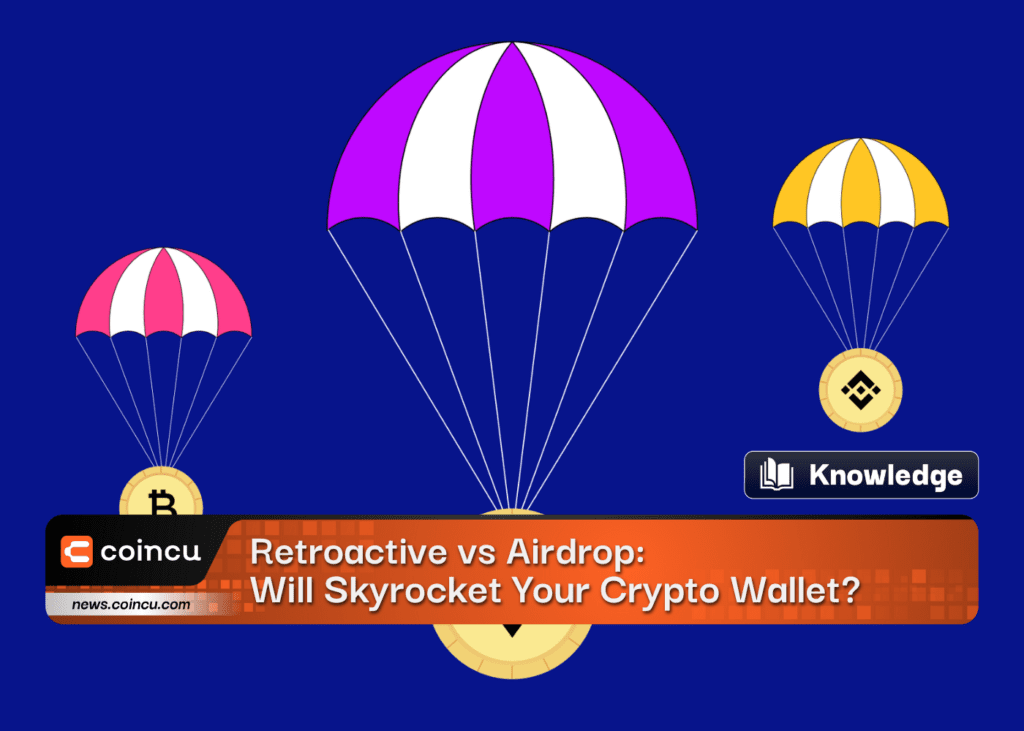What is Retroactive?

Retroactive distribution is a unique way of distributing tokens that has become increasingly popular in the world of cryptocurrency. It’s a distribution model where a project awards its tokens to the community at the time of TGE (Token Generation Event) instead of opening a public sale through a 3rd party. This distribution model has become popular among larger projects with longer development times and sufficient funds to spend, as it helps in achieving the goal of decentralization.
The retroactive distribution model is based on rewarding users who have contributed significantly to the development of the project. The recipients of retroactive tokens are usually those who have used the product early, both on the testnet and on the mainnet. This approach has been seen as a form of gratitude from the project towards its users.
The initial criteria for retroactive distribution were simple, such as the need to interact with the project by opening an account (as in the case of dYdX), swapping a few orders on Uniswap, or reaching a volume of $1000 on 1inch. However, as the popularity of retroactive distribution has grown, projects have had to become more stringent and filter out Sybil wallets or airdrop farmers to ensure that the tokens are distributed to genuine users who add value to the project.
One of the reasons behind the popularity of retroactive distribution is that it incentivizes early adoption of the project. It’s a way for projects to reward users who contribute to the development of the project and encourage more people to use the product early on. This approach also helps in achieving the goal of decentralization, which is a key focus of many blockchain projects.
Retroactive distribution has become a popular way for projects to incentivize early adoption and reward users who contribute to the development of the project. As the popularity of this approach continues to grow, projects will need to become more stringent in their criteria to ensure that the tokens are distributed to genuine users who add value to the project.
What is Airdrop?
airdrop in the context of cryptocurrency refers to the distribution of free tokens or coins to individuals. It is a marketing strategy often employed by blockchain projects or companies to raise awareness, gain a user base, or reward existing users.
During an airdrop, tokens or coins are typically distributed to eligible participants who meet certain criteria established by the project. These criteria can include holding a specific cryptocurrency, being a registered user on a platform, or participating in specific promotional activities.
Airdrops can take different forms. Some airdrops involve simply distributing tokens to existing cryptocurrency holders based on their wallet balances. Others may require participants to perform specific actions such as sharing social media posts, joining a Telegram group, or completing certain tasks to receive the airdropped tokens.
The tokens or coins distributed through airdrops may have different purposes. They can be utility tokens used within a specific platform or ecosystem, governance tokens that grant voting rights in decision-making processes, or even new cryptocurrencies that are being launched.
Airdrops serve several purposes. They can help bootstrap a community around a project, create buzz and publicity, and incentivize users to engage with the project. Additionally, airdrops can also be a way to distribute tokens fairly and decentralize ownership by reaching a wide range of participants.
Airdrop is a method used by cryptocurrency projects to distribute free tokens or coins to individuals as part of their marketing and community-building efforts.
Why Retroactive and Airdrop?
Retroactive measures and airdrops serve different purposes in the cryptocurrency industry. Here’s a breakdown of why these concepts are utilized:
Retroactive Measures:
- Correcting Mistakes: Retroactive actions can be taken to rectify errors or oversights made in the past. It allows for the adjustment of outcomes based on new information or changed circumstances.
- Fairness and Consistency: Retroactive measures can be implemented to ensure fairness and consistency in the application of rules or policies. They aim to create a level playing field for all participants involved.
- Adapting to Changing Conditions: Retroactive actions can be necessary when there are significant changes in laws, regulations, or market conditions that require adjustments to past events or transactions.
Airdrops:
- Community Building: Airdrops are often conducted to build a community around a project. By distributing tokens to participants, it helps attract attention, engage users, and foster a supportive ecosystem.
- Marketing and Promotion: Airdrops serve as a marketing tool to raise awareness about a project or cryptocurrency. They generate buzz, attract new users, and create a positive image for the project.
- Token Distribution: Airdrops provide a fair and decentralized way of distributing tokens. They allow projects to distribute tokens to a wide range of participants, increasing the token’s distribution and potentially decentralizing ownership.
- Incentivization: Airdrops incentivize users to engage with a project, such as joining social media communities, performing specific tasks, or holding certain cryptocurrencies. It encourages participation and rewards users for their involvement.
Both retroactive measures and airdrops are implemented to achieve specific objectives within the cryptocurrency industry. Retroactive actions address past events and seek to correct mistakes or ensure fairness, while airdrops focus on community building, marketing, token distribution, and incentivization.
Compare Retroactive vs Airdrop
Retroactive and airdrop are two distinct concepts in the cryptocurrency and blockchain space. Let’s compare them based on their meanings and purposes:
- Meaning:
- Retroactive: Retroactive refers to applying a rule, policy, or action to past events or circumstances. It involves taking action retrospectively.
- Airdrop: An airdrop is the distribution of free tokens or coins to individuals. It is a marketing strategy employed by blockchain projects to raise awareness, reward users, or build a community.
- Timing:
- Retroactive: Retroactive actions occur after an event or situation has already taken place.
- Airdrop: Airdrops are typically conducted before or during the launch of a cryptocurrency project to distribute tokens to participants.
- Purpose:
- Retroactive: Retroactive measures are often implemented to correct or modify outcomes based on new information or changed circumstances.
- Airdrop: Airdrops are primarily used as a marketing tool to attract attention, incentivize user engagement, or distribute tokens in a fair and decentralized manner.
- Implementation:
- Retroactive: Retroactive actions or changes can be implemented through legal, regulatory, or policy modifications that impact past events or transactions.
- Airdrop: Airdrops are implemented by blockchain projects by defining specific criteria or tasks for individuals to meet in order to receive free tokens or coins.
- Effect:
- Retroactive: Retroactive measures may alter the consequences or outcomes of past events, potentially affecting individuals or entities involved.
- Airdrop: Airdrops aim to increase awareness, create a user base, and distribute tokens to participants without directly modifying past events or transactions.
Retroactive refers to applying actions retrospectively to past events, while airdrop is the distribution of free tokens to individuals for marketing, community-building, or incentivization purposes.
Should you sell or keep the tokens received from Retroactive and Airdrop?
Whether to sell or keep the tokens received from retroactive measures or airdrops depends on various factors and individual circumstances. Here are some considerations to help you make an informed decision:
- Project Analysis: Evaluate the project behind the tokens received. Research the team, the technology, the roadmap, and the overall potential for success. Assess the project’s long-term viability and its alignment with your investment goals.
- Token Utility: Understand the utility and purpose of the tokens. Determine if they serve a valuable function within the project’s ecosystem or if they have the potential for future adoption and demand.
- Market Conditions: Consider the current market conditions and trends. Assess whether the market sentiment for the specific tokens or the broader cryptocurrency market is favorable or unfavorable.
- Portfolio Diversification: Evaluate your overall investment portfolio. Consider whether holding or selling the tokens aligns with your diversification strategy and risk tolerance. It may be beneficial to diversify across different cryptocurrencies and assets to mitigate risk.
- Tax Implications: Take into account any tax obligations associated with selling or holding the tokens. Tax laws vary by jurisdiction, and it’s important to understand the tax implications of your actions.
- Personal Financial Situation: Consider your financial goals, liquidity needs, and any immediate financial requirements. Selling the tokens may provide immediate access to funds, while holding them may offer potential long-term gains.
- Risk Assessment: Assess the risks associated with holding the tokens. Consider factors such as price volatility, regulatory changes, project-specific risks, and liquidity.
The decision to sell or hold the tokens received from retroactive measures or airdrops is a personal one that should be based on thorough research, risk assessment, and consideration of your financial goals and circumstances. It may be helpful to consult with financial advisors or professionals who specialize in cryptocurrency investments to gain additional insights.
Conclusion
Retroactive and airdrop are distinct concepts in the cryptocurrency space. Retroactive actions involve applying rules or actions to past events, often to correct or modify outcomes based on new information or changed circumstances. On the other hand, airdrops refer to the distribution of free tokens or coins to individuals as a marketing strategy, incentivizing user engagement or community-building.
Whether to sell or keep tokens received from retroactive measures or airdrops, it is crucial to consider various factors. These include analyzing the project behind the tokens, understanding their utility, assessing market conditions, diversifying one’s portfolio, considering tax implications, evaluating personal financial needs, and assessing associated risks.
DISCLAIMER: The Information on this website is provided as general market commentary and does not constitute investment advice. We encourage you to do your own research before investing.
Join us to keep track of news: https://linktr.ee/coincu
Annie
Coincu News





